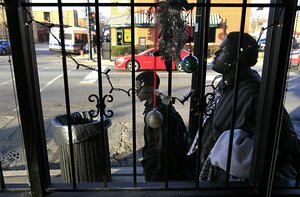Chicago registers its 500th homicide of 2012 – the highest number since 2008
Public-housing and school policies, gang activity, access to guns, and budget cuts for social programs have all been cited as factors in Chicago’s homicide rate.

Young men walk past the barred window of a business in the Auburn-Gresham neighborhood on Chicago's South Side. The violence in 2012 – 500 homicides in the city so far – has gripped a handful of neighborhoods, including this one.
Charles Rex Arbogast/AP
Chicago
Rahm Emanuel’s first full year as Chicago mayor ends on a tragic note: The city marked its 500th homicide Thursday evening, making 2012 the deadliest year in the city since 2008.
Overall, Chicago homicides are at a historic low compared to decades past – 928 in 1991, for example. But the last time Chicago homicides topped 500 was in 2008, when the number was 513. After that, murders had been falling. In 2011, there were 433 homicides.
Why homicide rates trend up or down is not easily explained by a single year, and it most certainly requires examining a series of complex factors including systemic unemployment, economic disenfranchisement, easy access to weapons, and – specifically in Chicago – the dismantling of public housing that started two decades ago and has coincided with the closings of public schools in distressed neighborhoods.
“The public-housing and school policies did a lot to undermine the fabric of marginalized communities on the South and West Sides of Chicago. That unraveling of the fabric continues to drive the desperation, the depression, the self-medication that contributes to a lot of this violence,” says Lance Williams, assistant director of the Jacob C. Carruthers Center for Inner City Studies at Northeastern Illinois University in Chicago.
School closings in impoverished neighborhoods and the increased push for privately operated charter schools became a major issue of contention during the public-teacher strike in September. The Emanuel administration has long said that while facing a ballooning budget deficit, it can’t afford to operate so many schools, especially those where student populations are dwindling.
Homicides in Chicago attracted national media attention early this summer when 7-year-old Heaven Sutton became the city’s 251st fatality, killed by a random bullet while operating her front-lawn candy stand on the city’s West Side. Mayor Emanuel and police superintendent Garry McCarthy blamed the growing violence on neighborhood gang factions, which they say are responsible for 80 percent of the shootings.
Gang factions are small groups that have splintered from the monolithic, often historic, crime organizations that date back decades. As many as 600 factions exist today, the Chicago Police Department says. Moreover, Chicago has surpassed Los Angeles in total gang membership and activity, crime experts say.
Much of the action that the city has taken this year has tried to take down gangs: Some 250 vacant buildings were demolished because they were considered gathering places for gangs, the police department partnered with antiviolence group CeaseFire to increase conflict mediation on the streets, and McCarthy has initiated a new system to assess turf affiliations to prevent retaliation shootings.
However, focusing solely on gangs is misguided, says Mr. Williams, among others who study crime. He says the shootings are often random, interpersonal, or petty.
“Guns are definitely a problem; gangs, absolutely not,” he says. “These are kids who, over the last 10 years or so, have been extremely marginalized, and this is their response to that marginalization. They feel stuck with a lot of rage. They can clearly see people in other neighborhoods making a lot of progress and being mobile, but they feel stuck in their communities and feel afraid. And because they have easy access to guns, it’s a form of desperation.”
Harold Pollack agrees and sees the wider problem connected to budget cuts for social programs, especially for the Office of Community Oriented Policing Services (COPS), a unit within the US Department of Justice that provides programs and funding to local, state, and county law-enforcement agencies.
Mr. Pollack, who is co-director of the University of Chicago Crime Lab, which studies public policy related to policing, says the recession has accelerated problems in inner cities. The federal government, he adds, “can’t expect local governments to solve all the problems on their own.”
“I look at the deficit conversation in Washington and look at neighborhoods in Chicago and think there’s a dramatic disconnect in priorities with what’s really at stake. I don’t see the same sense of urgency for the economic and social challenges in urban America,” he says.
The 500th homicide in Chicago was of Nathaniel Jackson, a black, middle-aged man who lived in Austin, a neighborhood on the far West Side. Mr. Jackson was shot while standing outside a grocery store. He was just released from prison in the summer, where he served a sentence for robbery.
Although blacks represented 33 percent of the city’s population in 2010, according to the US Census Bureau, city police data show that blacks represent about 76 percent of all victims.
Hispanics are 16 percent of Chicago’s homicide victims. They made up 29 percent of Chicago’s population in 2010.

